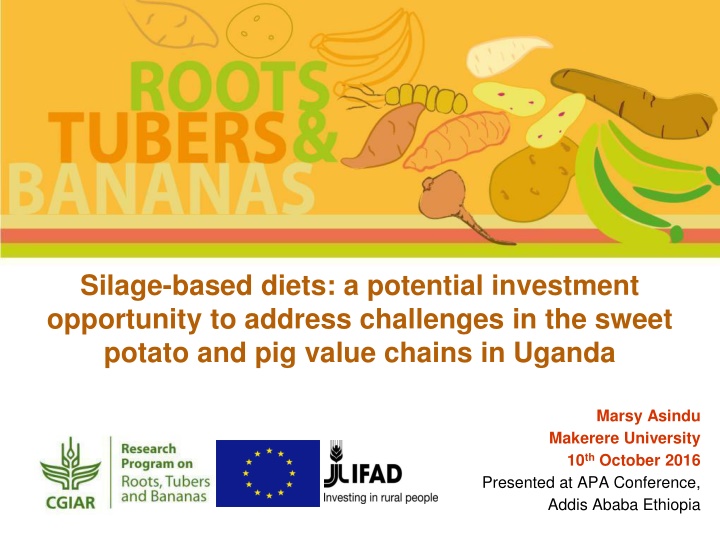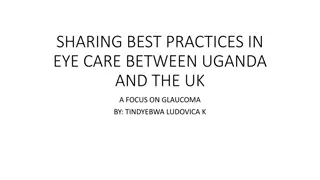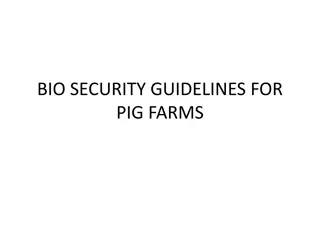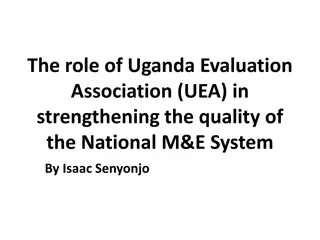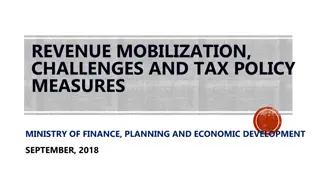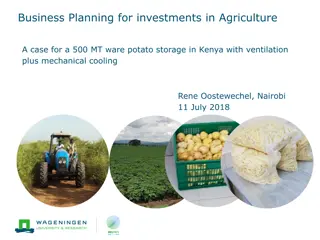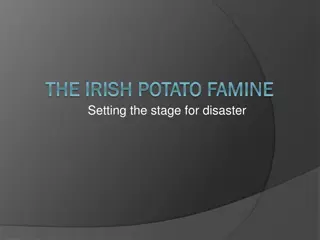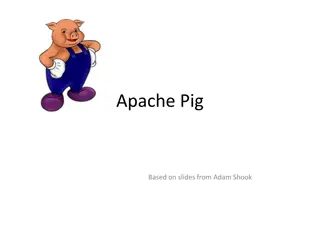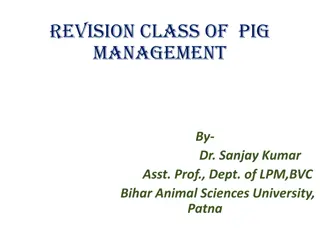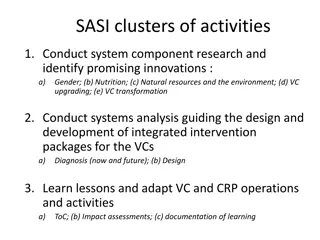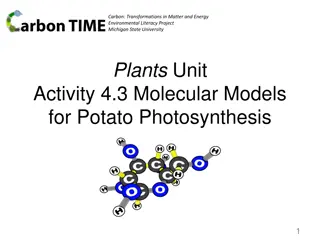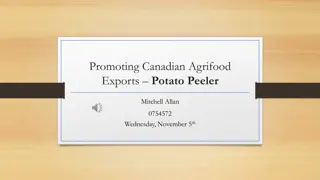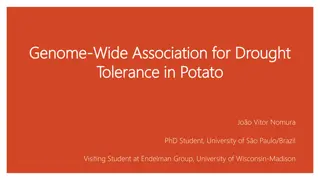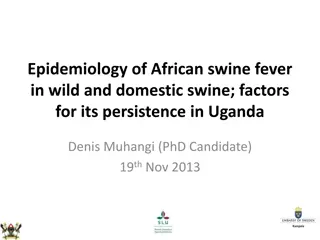Potential Investment Opportunity in Sweet Potato and Pig Value Chains in Uganda
Silage-based diets offer a promising investment opportunity to address challenges in sweet potato and pig value chains in Uganda. The study focuses on assessing the production and utilization of sweet potato products, mapping out the value chain, estimating wastage, and identifying opportunities for investment in silage making. By understanding the relationships between pig and sweet potato value chain actors, the research aims to enhance feed conservation and reduce seasonal shortages in livestock feed.
Download Presentation

Please find below an Image/Link to download the presentation.
The content on the website is provided AS IS for your information and personal use only. It may not be sold, licensed, or shared on other websites without obtaining consent from the author.If you encounter any issues during the download, it is possible that the publisher has removed the file from their server.
You are allowed to download the files provided on this website for personal or commercial use, subject to the condition that they are used lawfully. All files are the property of their respective owners.
The content on the website is provided AS IS for your information and personal use only. It may not be sold, licensed, or shared on other websites without obtaining consent from the author.
E N D
Presentation Transcript
Silage-based diets: a potential investment opportunity to address challenges in the sweet potato and pig value chains in Uganda Marsy Asindu Makerere University 10thOctober 2016 Presented at APA Conference, Addis Ababa Ethiopia
Presentation outline Introduction Objectives Materials and Methods Main findings Conclusions
Introduction Sweetpotato is an important crop in Eastern Africa and a major staple food in Uganda. Uganda produces 1.8 million MT from 440.000 hectares. High priority to sweetpotato research consequently resulting in the release of several varieties over the years. Sweetpotato is used as food, livestock feed and, at less extent, in industrial processes to make alcohol and starch. However, recent studies show that sweetpotato potential as an animal feed has not been fully exploited in Uganda (CIP, 2012).
Introduction contd Sweetpotato production is positively associated with pig production (Huang, 2003). In Uganda about 1.1 million households own an estimated 3.2 million pigs, primarily managed as a backyard activity (UBOS, 2009). Among these households sweetpotato residues are the preferred fodder (Ouma et al., 2014). Since the availability of this residues is highly seasonal, adoption of technologies that conserve feeds such as sweetpotato silage would go a long way to reduce seasonal feed shortage. However, success of the silage technology is dependent on the availability of vines and rejected sweetpotato roots, thus this study.
Objectives General objective To assess the production and utilization of sweetpotato products and the relationships between pig and sweetpotato value chains actors in two major pig production districts of Uganda, Kamuli and Masaka Specific objectives To map out the sweetpotato value chain To estimate the amount of sweetpotato root and vine wastage by chain actors To identify challenges and opportunities for investment in sweetpotato silage making
Materials and Methods Study area: Kamuli in the Eastern region and Masaka in the Central region Sample procedure: multistage sampling technique Sample size: 240 interview respondents, 180 FGD participants and 2 key-informants Data collection: FGDs, Key-informant interviews (guided by semi-structured checklist) and structured questionnaire Data analysis: qualitative and quantitative
Main findings Sweetpotato value chain map
Sweetpotato production and utilization Sweetpotato vine and root yield in Kamuli and Masaka districts Season Average land Vine yield Root yield % Big % Small % Low allocated (acres) (kg/acre) (kg/acre) roots roots quality roots Season 1 0.95 (0.6) 1487.6 (1156.9) 2526.8 (1204.9) 54.6 27.7 17.7 Season 2 0.96 (0.4) 3464.8 (1310.7) 2536.9 (931.6) 48.5 32.0 19.5 Average 0.95 (0.4) 2476.2 (924.2) 2531.9 (897.7) 51.5 29.9 18.6
Sweetpotato production and utilization Utilization of sweetpotato components by farmers Sweetpotato component Usage (%) Food Planting material Animal feed Sell Manure Given to neighbours Thrown away Big roots 67.5 0.0 0.0 32.5 0.0 0.0 0.0 Small roots 72.6 0.0 21.3 3.0 0.0 0.1 3.0 Low quality roots 16.9 0.0 59.5 0.6 0.4 0.8 21.8 Peels 0.0 0.0 82.7 0.0 5.2 1.0 11.1 Vines 0.0 28.6 44.2 2.2 0.6 0.2 24.2
Wastage by SP farmers SP Farmers waste on average 599.2kg of vines per acre per season Vine wastage is higher for farmers without pigs (710.7kg) compared to the ones with pigs (541.4kg) Kamuli district has a higher wastage of vines compared to Masaka (672.2kg vs 522.3kg) About 4.95% of the farmer s total harvested roots is thrown away (125.3kg per acre per season) About 11.1% of peels produced at farm level is wasted (45.3kg per acre per season) and an additional 5.2% is used as low value green manure (21.3kg per acre per season)
Wastage by SP traders SP Traders throw away 3.75% of their entire root stock due to spoilage and damage during transportation (particularly in Feb and Aug-Dec) Some traders have arrangements with local pig farmers who purchase deteriorated roots at a reduced price (as low as 50 UGX/kg) Traders deal with vines only meant to be sold to farmers as planting material, not as feed. Just a few traders (5%) reported wastage of vines
Wastage by SP consumers SP Processors Peelings given to animals mostly pigs. Those without pigs give it away to neighbouring pig farmers for free or at an average price of UGX 22 per kg SP Consumers Peelings given to animals particularly pigs. Those without livestock throw them away or give to neighbours with animals free of charge Institutions collect and pack peelings in sacks in fresh or dry form and sell to livestock farmers, especially pig farmers at UGX 10 to 30 per kg depending on the season
Pig farmers feeding challenges Almost all pig farmers (98.3%) actively engaged in sweetpotato production Those not growing sweetpotato or in short supply obtain vines and low quality roots from neighbouring farmers for free or at a very low price Those in peri-urban areas purchase deteriorated roots from urban traders (UGX 174/kg) No vines are purchased from traders. Conversely, peels from farmers, processors, individual consumers and institutions are purchased Some wastage during feeding (selective)
Proportion of pig farmers facing feed scarcity by month 90 83.3 76.7 80 68.3 68.3 70 Percenage of pig farmers 60 50 40.0 38.3 40 28.3 30 20 10.0 6.7 10 3.3 3.3 3.3 0 Jan Feb Mar Apr May Jun Jul Aug Sept Oct Nov Dec Months At time of feed scarcity, farmers supplement the limited feedstuff available on-farm, often of lower nutritional value (i.e., rotten mangoes and jack fruits) with commercial maize bran Maize bran is of poor quality and very expensive (av. 602 UGX/kg with peaks of 950 UGX/kg)
Conclusion The use of sweetpotato residues for livestock and particularly pig feeding is a common practices Nevertheless a substantial amount of vines, roots and peelings are wasted, particularly at farm level and by those without pigs Key challenges for SP farmers include the non-existence or underdeveloped nature of the market of vines for feed, short shelf-life of sweetpotato roots and vines, and low prices offered for roots during peak seasons Pig farmers are constrained by scarcity of vines and roots during off-seasons and lack of knowledge on conservation technologies Sweetpotato silage making has the potential to translate these challenges into opportunities for the benefit of both SP and pig value chain actors On going research is assessing farmers willingness-to-pay and its economic viability
